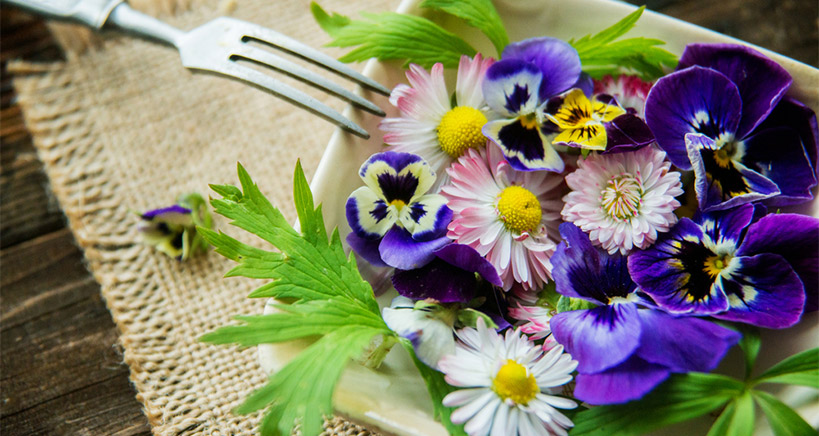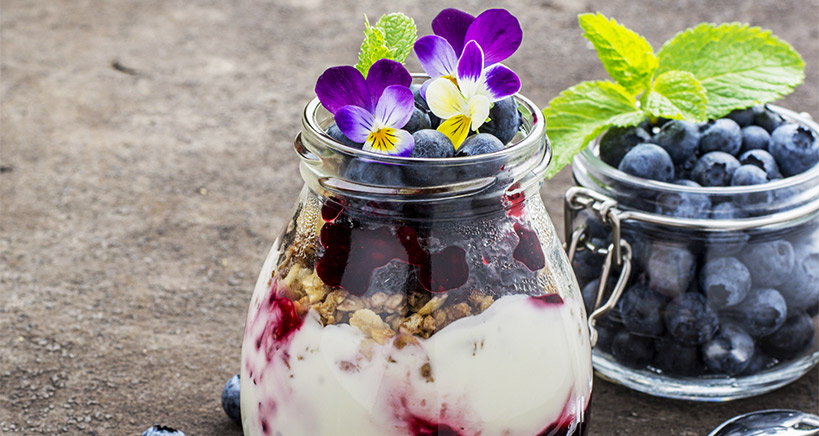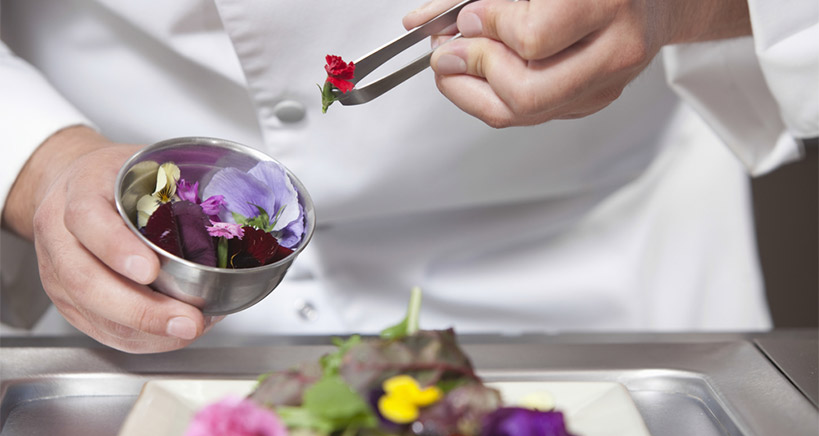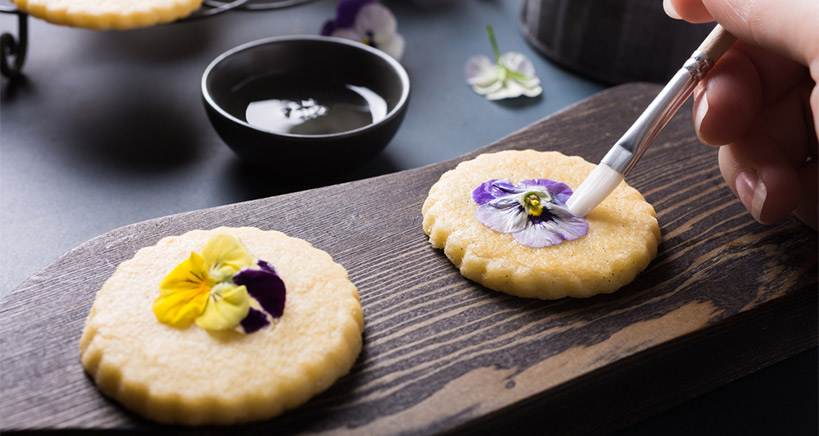
How to Use Edible Flowers
Cooking with edible flowers is once again a trend. After going out of style for many years, cooking and garnishing with flowers is back in vogue and on the buffet tables at catered events everywhere. As a savvy caterer, it’s time for you to embrace the edible flower trend to add a touch of elegance to all your affairs.
The Use of Edible Flowers Goes Way Back
In “The Edible Flower Guide: Cooking with Flowers from the Garden,” the Gardening Channel offers advice and tips on using edible flowers safely and beautifully, and lists the many edible varieties, including those we’ll mention below. As the site explains, edible flowers are experiencing a renaissance, of sorts. They’re popping up everywhere – on top of wedding cakes, in cocktails and even in soups and salads. And not just the usual and well-known edibles, like lavender or nasturtium; in addition to the tried-and-true favorites, other flowers, like pansies, tulips, violets, and orchids are getting the culinary treatment.
Using edible flowers can be traced back to Roman times, and to the Chinese, Middle Eastern, and Indian cultures. A tad more recently, edible flowers were also popular in the Victorian era (1837 – 1901) during Queen Victoria’s reign. Today, many restaurant chefs and caterers have once again started to garnish their entrees with flower blossoms adding, color and class to any event.
Types of Edible Flowers
Ode à la Rose, a unique florist in New York City, has posted a comprehensive guide to edible flowers that covers everything from A to Z. Whether sprinkled on a salad, incorporated into a cocktail or ice cubes, or candied for a cake, these blooms promise to add a lovely and elegant touch to your entertaining efforts.

Here are just some of the flowers that work well in a culinary setting and that you should consider incorporating in your repertoire at upcoming catered affairs:
Borage blossoms: These lovely blue star-shaped flowers from the borage plant taste a bit like cucumbers, which is why they’ve been used for centuries. They are also delicious in lemonade and cocktails. Due to their versatility and taste they can be used in both sweet and savory dishes.
Calendula: Sometimes referred to as the “poor man’s saffron,” calendula – or the marigold flower – really does taste like saffron when it’s lightly sautéed in olive oil to release its flavor. The golden-hued petals can also go uncooked to add a subtle, slightly spicy taste to appetizers like deviled eggs.
Hibiscus: These flowers are similar to cranberries in that they impart both a delicious sweetness and a tangy tartness. These qualities make them great in teas and cocktails, or at the bottom of a glass of sparkling, bubbly wine.
Lavender: Most people are familiar with the sweet and slightly perfumed smell of lavender (though they may not know what it is they’re smelling). The pastel-colored lavender leaves are perfect in cocktails or sprinkled over frosted chocolate cake (the contrast in colors is beautiful).
Nasturtiums: The nasturtium flower has a slightly peppery taste, making them perfect for salads or baked into savory tarts. You can also stuff a whole flower with a cream-cheese filling, enticing all the senses at once.
Pansies: The pansy’s flavor is a slightly minty, somewhat grassy taste that goes well with summer-time fruit salads and refreshing cocktails. Pansies also work well as garnish atop spread-covered crackers.
Sage flowers: Everyone is familiar with sage as an herb, but not everyone realizes that the flower of the sage plant is also edible and delicious. The beautiful flower has a taste that is both sweet and savory at once and it can be added to refreshing popsicles for a thoroughly modern treat.
Violets: Violets come in a glorious range of colors and they have a floral-based sweet taste. Use them on salads or cold drinks, like iced tea. You’ll make a big splash, as well, if you crystallize the flowers (coat them with sugar) and use them on top of iced cupcakes and other desserts.
Zucchini blossoms: The bright yellow flowers of the zucchini plant (a.k.a. the courgette) have a delicate and slightly sweet taste. Sprinkle them on pizza for a thoroughly original twist to an old favorite.

How to Choose Edible Flowers
To keep your edible flowers as safe as possible for your guests, avoid using flowers that were sprayed with pesticides or other chemicals. To ensure the quality of your edible flowers – and their suitability in your dishes – buy them from the produce section of your supermarket or from online sources, like The Chef’s Garden or Gourmet Sweet Botanicals.
Preparing Edible Flowers
When cooking with or serving edible flowers, clean them by washing them gently in a large bowl of cold water and letting them air dry on a paper towel. Use them immediately or store them in the refrigerator for up to a week in an airtight container lined with a damp paper towel. If properly prepped, marigolds can stay fresh for a as long as a month in the refrigerator.
There is one essential rule to using edible flowers: adding flowers to a dish should be the last thing that you do before serving time. Flower petals are very sensitive to acid, and since most dishes have some sort of acidic ingredient, these components tend to make the petals fall apart and look worn out. Prepare everything – salads, desserts, drinks, etc. – and at the last minute sprinkle on the flowers and they’ll be fresh and attractive.
Also important is to let your clients know ahead of time that you like to use edible flowers, as there is a health concern involved. Asthmatics sometimes have allergic reactions to certain flowers, such as calendula, chrysanthemum, daisies and marigolds, and you should discuss this aspect of edible-flower use with customers ahead of time.

Edible Flowers Tips and Hints
Using edible flowers as a garnish makes any dish look special on your table. Here are a few ideas to beautify your recipes and bring the flavors alive:
- Place a colorful hibiscus flower in a clear glass bowl and fill with your favorite dip.
- Freeze whole small flowers into ice cubes for a pretty addition to punches, cocktails, and other beverages.
- Use edible flowers in a variety of flavored oils, salad dressings, and marinades.
- Never use non-edible flowers as a garnish. This may seem like a given, but although some particularly gorgeous blossoms may seem irresistible, you don’t want your guests assuming they’re edible and then discovering they are not.
- Overuse of edible flowers falls into the too-much-of-a-good-thing category. Don’t overdo it, as most people are not used to eating these blossoms. If they’re found in everything you serve, they can lead to stomach issues in the uninitiated, particularly those with sensitive guts.
Have Fun with Flowers
Nothing says spring like bright, beautiful flowers topping a delicious dip; miniature appetizers; or even the main entree. The culinary uses for flowers are endless; use them sprinkled on salads, floating atop soups, or even on open-faced sandwiches or wraps. Edibles flowers are eye-catching, so use them to make your dishes pop. Finally, have fun with them and be creative. Your guests will be impressed, and your next catered event will be lavish and unforgettable.